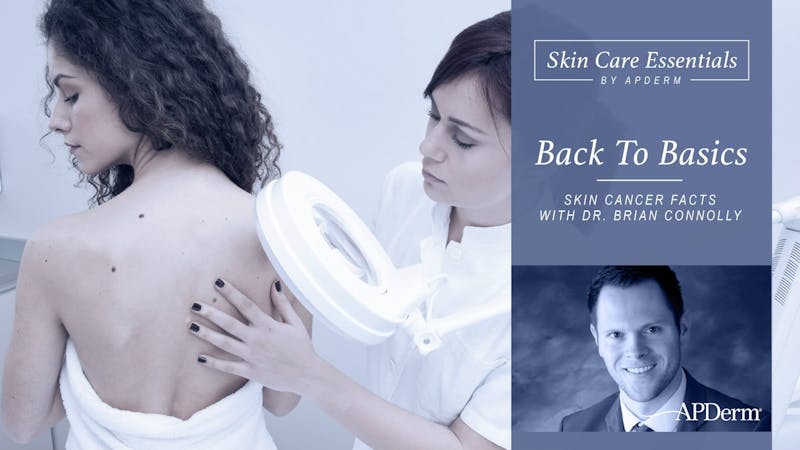Your Family Deserves the Best Care Book an Appointment
Your skin health matters, so don’t delay. Our clinicians look forward to treating you and your family at one of our local New England practices.
Find Your Nearest APDerm Center
If you’ve been layered up in heavy clothes all winter, you may not think to give your skin a good scan. Or maybe you have, and you’ve noticed a warty growth that is big, ugly and bleeds when you pick it.
Take a deep breath and relax, says Dr. Brian Connolly, MD, FAAD, who practices at Adult & Pediatric Dermatology in Portsmouth, New Hampshire. Connolly recently hosted a Facebook live presentation on skin cancer facts to help allay people’s fears and explain the signs and symptoms you should watch out for.
His advice: You definitely shouldn’t ignore an unusual mole or skin growth, but oftentimes it is a benign type of skin cancer or a seborrheic keratosis.
Most people know to keep an eye on unsightly moles that grow or change colors or shape. Often, it’s the first visible sign of skin cancer. If you’re a ginger, fair-skinned, or have freckles, you’re especially susceptible.
There are two different kinds of skin cancer. One type is slow-growing and relatively harmless and one is more dangerous. You’ve most likely heard of melanoma, but it is not nearly as common as non-melanoma skin cancers. There are many different subtypes, but the two most common are basal cell carcinoma (BCC) and squamous cell carcinoma (SCC).
Melanoma: The most dangerous form of skin cancer can be deadly if it goes undetected due to its ability to spread to other areas if it is not treated early.
Non-melanoma: This type of cancer, if caught early, has a good prognosis of recovery. There are many different subtypes, including Basal Cell Carcinoma (BCC) and Squamous Cell Carcinoma (SCC).
Seborrheic keratosis: Benign, warty growths that occur with advancing age.
A cancer formed from cells in the skin called melanocytes that normally give skin its color. There are several risk factors including:
When it comes to identifying a cancerous mole, remember to monitor skin growths for the ABCDEs of melanoma!
A is for Asymmetry – One half of the spot is unlike the other half,
B is for Border – Spot has an irregular, scalloped, or poorly defined border.
C is for Color – Color varies from one spot to the next, such as shades of tan, black, or brown, or areas of white, red or blue.
D is for Diameter – Melanomas are usually greater than 6 millimeters, or about the size of a pencil eraser, when diagnosed, but they can be smaller.
E is for Evolving – The spot looks different than the rest or is changing or evolving.
If you’re concerned about the look or shape of a mole, try not to panic. Many people worry or ruminate over worst-case scenarios before receiving a proper diagnosis.
A biopsy is what helps provide the proper diagnosis. Your doctor will take a small piece of tissue and send it to a pathologist for analysis.
Receiving a diagnosis can be scary, but there are several treatment options that have good results, especially if your cancer is caught early.
One question to ask is how deep is it? The therapy is dependent on the depth of melanoma, and the depth has significant prognostic implications, Connolly says.
At Stage 1, it’s often a matter of cutting out the cancerous growth. Deeper ones that go into the skin involve more extensive treatment measures, and that’s when there is the potential to spread to other organs.
Some moles and skin growths are less severe but still can pose a health hazard. If they pop up on your face, they also may affect your self-esteem. One big difference is non-melanoma skin cancers are relatively common and are very slow-growing.
There are many subtypes of non-melanoma skin cancers, but the two most common include:
Things to remember:
Treatments for non-melanomas are different than for melanoma, especially if it’s caught early and on the outer layer of skin. The type of treatment depends on many factors, including the size of the cancer, location, and depth of growth. You have a few options, so talk to your dermatologist about which treatment would be best for you. It needs to be decided on an individual case-by-case basis.
There are many options for treatment of these cancers:
Electrodesiccation and Curettage is a good option for smaller and more superficial skin cancers.
Mohs Surgery is a state-of-the-art treatment and a more intricate surgery that removes skin cancer down to its roots. The surgery involves removing the skin cancer and immediately freezes it to examine under a microscope and see if any skin cancer is left.
Another common growth is called a seborrheic keratosis. These benign warty growths typically show up as you get older.
It’s important to stay vigilant and know what you need to look for. Contact APDerm today if you are concerned about possible skin cancer or other growths. It’s not worth losing sleep over! Our team can evaluate your skin issues and give you a proper diagnosis.